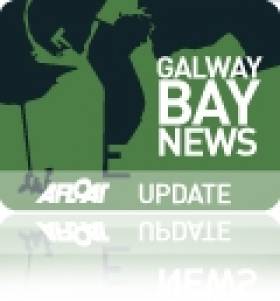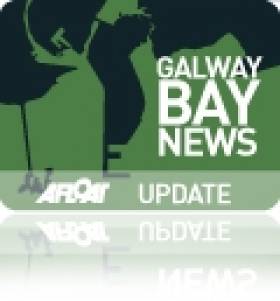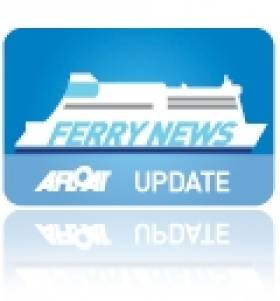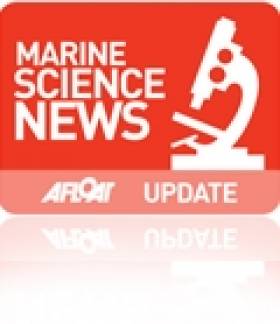Displaying items by tag: Galway Bay
Public Meetings On Aran Islands Air Service Today
#AranIslands - Public meetings will take place across the Aran Islands today over changes to the islands' air service.
As previously reported on Afloat.ie, residents of the Galway Bay island chain have expressed concerns over the replacement of their longtime daily plane services to the mainland with helicopter flights that are set to begin next month.
Later today (Wednesday 16 September) Inis Mór, Inis Meáin and Inis Oirr will host a number of TDs, senators and Galway city and county councillors to address the "ongoing uncertainty" about the future of the air service, which will continue to fly for the time being till February 2016, as Galway Bay FM reports.
In other Galway news, the city is making preparations to deal with what are feared to be the highest tides in two decades.
Waters are expected to rise as much as 20 feet on Sunday 27 September - well above the Spanish Arch quay wall. Galway Bay FM has more on the story HERE.
Galway Bay 'Fish Dump' Investigated
#GalwayBay - Dead fish allegedly dumped off Spiddal beach on Galway Bay recently are the subject of an investigation by fisheries protection officials, as The Irish Times reports.
Local campaigners against the proposed salmon farm off the Aran Islands said last week's discovery comprised carcasses of farmed salmon - claiming a tag with the Marine Harvest Island label was found on one of the fish.
Galway Bay Against Salmon Cages also expressed its fears that the fish dump could have "infected" Galway Bay's migrating wild salmon with viruses associated with fish farms.
However, Marine Harvest – which last year was in the news over a controversial freshwater pipeline to treat a disease outbreak at a farm in Kilkieran Bay – said it had no involvement in the alleged fish dump, and no reports of viruses at its aquaculture sites.
The Irish Times has more on the story HERE.
Galway's Successful Launch of 'Try Sailing'
#trysailing – Galway Bay Sailing Club held the West of Ireland's first " Try Sailing " launching over the weekend, with up to 400 people getting on the water yesterday for the ISA's new initiative, which is part of an Access and Participation programme linked with Irish Water Safety to promote water safety and sailing.
Developed from a suggestion from Muriel Rumball of the Irish National Sailing School in Dun Laoghaire, the linkup with IWS allows promotion of the programme in schools, and the numbers involved showed the success of this approach.
Around 175 were complete beginners who had never before been on the water in Galway. And it was like the previous night 's Eurovision, with eleven different nationalities represented - our "new Irish" citizens are keen to get afloat.
The Day was co-ordinated by GBSC Public Relations Officer Phyllis Hayes, who organised up to 60 boats and nearly 220 members including juniors, parents, instructors and officers. Irish TV.ie covered the day's events, which will be broadcast on 15th June , which is the first day the first day of IWS Water Safety Week. And there will be another Try Sailing initiative to round out the week on June 21st, Midsummer's Day.
Campaign Against Galway Bay Fish Farm Blasts PR Spend
#FishFarm - Bórd Iascaigh Mhara (BIM) has been blasted by campaigners against its proposed Galway Bay salmon farm for spending tens of thousands of euro on PR for the controversial project.
According to the Connacht Tribune, Galway Bay Against Salmon Cages described as "worrying" the more than €57,000 paid to PR firm Keating & Associates for "communications service", just one of various spends on private consultants totalling more than half a million euro.
The group also expressed concern over letter sent on behalf of BIM to the editors of national newspapers, citing them as an effort to "stifle debate".
However, BIM says the letters were issued "in order to address the publication of inaccuracies regarding BIM and the Galway Bay application".
It also defended the expenditure on consultants as normal operating costs, claiming it regularly hires outside expertise when needed.
Local groups opposed to the 500-hectare salmon farm off the Aran Islands – which would be largest aquaculture project of its kind in Europe – continue to wait for Marine Minister Simon Coveney to make a decision on BIM's licence application, which was originally promised before this summer.
The Connacht Tribune has more on the story HERE.
#GalwayBay - The freezing Atlantic waters of the Galway Bay coast might seem like a strange place to find a women's Gaelic football team in full-on training mode.
But for the Galway senior ladies squad, a quick dip in the chilly sea at Silver Strand was just the ticket to push them "to the next level" in their quest for the Division One league title in tonight's final replay (Saturday 16 May).
As strength and conditioning coach Ann Caffrey told the Connacht Tribune, the unorthodox seaside training session following their draw against All-Ireland champions Cork was the right option for her women "because a tough match deserves a tougher recovery".
Galway Bay 'Mackerel Festival' Proposed For Salthill Promenade
#GalwayBay - A new mackerel-themed maritime festival has been proposed for Galway Bay this autumn – as the latest industry figures show tourism in the region is heavily concentrated in the summer months.
The Connacht Tribune reports on the 'Mackerel Festival' idea suggested at a Galway Chamber meeting last week as a way to rejuvenate Salthill.
Along the lines of the recent Dublin Bay Prawn Festival, the event would liven up the seaside suburb's renowned Promenade with a celebration of its local mackerel catch, which brings in big numbers each September.
The event was one of a number of ideas, including reopening Salthill's tourist office, put forward at the meeting last Tuesday (21 April) that agreed to form a committee to advance the most promising plans.
And the news comes as the latest figures from Fáilte Ireland show that a third of all visitors to Galway in 2014 were 'shoehorned' into the two high summer months.
According to the Connacht Tribune, a combined total of 33% of Galway visitors arrived in July and August last year.
June and September are the next busiest months with 24% of all visits between them, as opposed to just 3% in January – underlining the highly seasonal nature of the region's tourism industry.
The figures were released as part of a public consultation on the Wild Atlantic Way and the initiative's effects on the coastal environment.
Consultation Planned For Galway Bay Coastal Walkway
#GalwayBay - Galway City Council will soon open a public consultation on a proposed new walkway between Salthill and Silverstrand, as the Galway Advertiser reports.
The new Galway Bay coastal walking route will comprise a series of "scenic pathways and footbridges spanning the shoreline" between the Salthill Promenade and the beach at Silverstand in Barna two miles to the west.
And the €7 million project also involved works to protect from coastal erosion, which will speed up the foreshore licence application process once the views of the pubic have been sought.
The Galway Advertiser has more on the story HERE.
Burren Ferry To Boost Galway Bay Tourism
#FerryNews - Today (Saturday 18 April) sees the launch of a new passenger ferry service across Galway Bay between the city and the Burren.
As the Clare Champion reports, the new ferry routes – which will see boats sail between Galway and the villages of Ballyvaughan and Kinvara on alternate days – are operated by MacMara, a new coastal ecotourism business.
MacMara founder Michael McArdle was part of the Ballyvaughan Bay Hop project, which ran a fast ferry service between the Burren and Galway City to coincide with the Volvo Ocean Race finale.
That feasibility study fed into the new service, which fellow Bay Hop operator Gwen Ryan has been refocused from commuting to "leisure travellers and bringing people from Galway City to the Burren and South Galway."
It's also expected that the MacMara service will open more of the Galway Bay coast to the tourism opportunities afforded by the Wild Atlantic Way initiative.
The Clare Champion has much more on the story HERE.
'Ocean Observatory' For Galway Bay
#MarineScience - A subsea cable laid from the RV Celtic Explorer in Galway Bay this week marks a major milestone in the development of Ireland's national marine research and development infrastructure.
The four-kilometre cable and a frame to which sensors and monitoring equipment will be attached are part of the development of an ocean observatory in Galway Bay connecting the Galway Bay Ocean Energy Test Site to the shore at Spiddal, Co Galway.
The cable will supply power to the site and allow unlimited data transfer from the site for researchers testing innovative marine technology including renewable ocean energy devices.
The Marine Institute and the Sustainable Energy Authority of Ireland (SEAI) have been working together to promote and develop Ireland's ocean energy potential, and this project – with partners SmartBay Ltd, UCC (MarEI - Marine Renewable Energy Ireland), and Dublin City University – is part of a programme to enhance the Galway Bay Ocean Energy Test Site.
A suite of sensors and environmental monitoring equipment will be installed on the cable end frame this summer, as well a floating 'sea station' which will give developers real-time data on how their devices are performing in the ocean.
"Ireland's sea area is around 10 times the size of our land area and with one of the best offshore renewable energy resources in the world, the opportunities to harness the power of the ocean are immense," says Marine Minister Simon Coveney.
"The new facilities at the Galway Bay Ocean Energy Test site will attract companies and researchers developing marine technology and renewable ocean energy equipment, and will position Ireland at the forefront of these emerging sectors by developing an expert indigenous supply chain that will expand as these sectors grow.
"The ocean observatory will also enhance our ability to monitor the ocean and better understand how it works, which is critical to tackling issues such as climate change."
Energy Minister Alex White adds that "offshore renewable energy has the potential to be a major component of Ireland's future energy mix and it is vital that we facilitate developments like this one in Galway Bay.
"Over time, the introduction of ocean energy into Ireland's renewables portfolio will enhance the security of Ireland's energy supply, deliver green growth, and add to the 47,000 jobs already supported by our energy sector.
"Government support for ocean research, development and demonstration has been increasing with €16.8 million added to my department's multi-annual ocean energy development budget between 2013 and 2016, bringing the total cumulative funding to over €26 million."
Instrument nodes and sensor packages to be installed at the Galway Bay Ocean Energy Test Site this summer will contribute to marine sectors including environmental monitoring, shipping, maritime security and education.
Extensive historical wave and weather data is also available for this site since 2008 and is available to potential device developers.
The new research infrastructure is expected to position Galway Bay as a unique world-class ocean energy test site.
The addition of a cabled ocean observatory means Ireland will also play an important role in the Atlantic Ocean Research Alliance between Europe, the USA and Canada under the Galway Statement signed at the Marine Institute Galway in May 2013 – and under which the RV Celtic Explorer will undertake the first transatlantic mapping survey between Galway and Newfoundland this coming June.
The cable project is funded in part by Science Foundation Ireland (SFI) under its Research Infrastructure Call 2012 which contributed €2.2m to the project. The Department of Agriculture, Food and the Marine contributed an additional €600,000 to the project in 2014. The Department of Communications, Energy and Natural Resources will fund additional infrastructure and the ongoing operations of the Galway Bay test site through the SEAI Ocean Energy Programme.
More information on the project will be available at www.marine.ie and www.oceanenergyireland.com.
Cork Harbour Summer Home Has Nautical Style
#WaterfrontProperty - A modernised 1920s summer home on Cork Harbour is on the market for a cool €1.2 million.
But as the Irish Examiner reports, Tanglewood in Currabinny is worth every penny – and might well be a bargain to those with multiple millions to splash out on superyachts.
The house and grounds are deserved as "in better order, and – dare to say, more ship-shape – than ever in its almost 100 years of proud standing."
Its most recent makeover 15 years ago saw the addition of a new upper east wing with double guest accommodation furnished in a nautical style care of local yacht designer Rob Jacob.
Outside the grounds include a Japanese-styled garden, and a private gate into the local Coillte woods.
But the star attraction might well be its waterfront aspect, at an elevated site above Currabinny pier. The Irish Examiner has much more on this property HERE.
Elsewhere in Cork, a modest two-bed seaside home in nearby Myrtleville could be yours for €350,000.
Ceann Mhara – Head of the Sea – is "a peach by a beach", combining its shoreside setting with a sunny aspect and proximity to popular local swimming hoe Poulgorm, which it sits right above.
And its value is expected to rocket as the summer months approach, so any interested parties should take a look while they can! The Irish Examiner has more HERE.
For those with more majestic tastes, however, there's Ardfry House in Oranmore, as the Connacht Tribune reports.
This 16,700sqft detached period house with outbuildings and an orchard on more than 28 acres is an attraction in and of itself – it was the setting of Hollywood spy thriller The Mackintosh Man in the 1970s – and its quality reflected in the €2 million guide price.
But also on its grounds are the remains of a ninth-century moated castle with the best part of a kilometre of sea frontage on a peninsula in Galway Bay, opposite the world famous golf resort.






































































